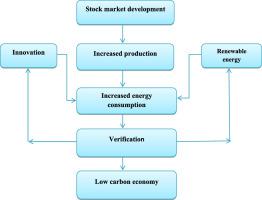Journal of Environmental Management ( IF 8.7 ) Pub Date : 2021-07-27 , DOI: 10.1016/j.jenvman.2021.113248 Rajesh Sharma 1 , Muhammad Shahbaz 2 , Avik Sinha 3 , Xuan Vinh Vo 4

|
The growing size of stock market in the South Asian countries might have contributed to raising the level of industrial production and energy consumption. This upturned energy usage might have widened the scope for carbon emissions because these nations heavily rely on fossil fuels. In this milieu, therefore, in the present study, we assessed the impacts of stock market development, per capita income, trade expansion, renewable energy solutions, and technological innovations on carbon intensity in the four South Asia countries from 1990 to 2016. The empirical results based on the CS-ARDL approach revealed that stock market development, per capita income, and trade expansion invigorated carbon intensity in the South Asian countries. On the contrary, the increased usage of renewable energy solutions and technological advancement helped in reducing the energy-led carbon intensity. Further, the interaction of stock market with renewable energy, and subsequently with technological advancement delivered insignificant coefficients, which indicates the inefficacy of renewable energy and technological advancement in regulating stock market-led carbon intensity during the study period. Therefore, by considering the need for complementarity between economic growth and environmental targets, we proposed a multipronged policy framework, which may help the selected countries to attain the Sustainable Development Goals, with a special focus on SDG 7, 8, 9, and 13.
中文翻译:

考察股票市场发展对碳强度的时间影响:来自南亚国家的证据
南亚国家股票市场规模的扩大可能有助于提高工业生产和能源消费水平。这种上升的能源使用可能扩大了碳排放的范围,因为这些国家严重依赖化石燃料。因此,在此背景下,在本研究中,我们评估了 1990 年至 2016 年四个南亚国家的股票市场发展、人均收入、贸易扩张、可再生能源解决方案和技术创新对碳强度的影响。基于 CS-ARDL 方法的结果表明,股票市场发展、人均收入和贸易扩张刺激了南亚国家的碳强度。相反,可再生能源解决方案的使用增加和技术进步有助于降低以能源为主导的碳强度。此外,股票市场与可再生能源以及随后与技术进步的相互作用传递的系数不显着,这表明研究期间可再生能源和技术进步在调节股票市场主导的碳强度方面效率低下。因此,通过考虑经济增长与环境目标之间互补的必要性,我们提出了一个多管齐下的政策框架,可以帮助选定的国家实现可持续发展目标,特别关注可持续发展目标 7、8、9 和 13。随后随着技术进步产生的系数不显着,这表明研究期间可再生能源和技术进步在调节股票市场主导的碳强度方面效率低下。因此,通过考虑经济增长与环境目标之间互补的必要性,我们提出了一个多管齐下的政策框架,可以帮助选定的国家实现可持续发展目标,特别关注可持续发展目标 7、8、9 和 13。随后随着技术进步产生的系数不显着,这表明研究期间可再生能源和技术进步在调节股票市场主导的碳强度方面效率低下。因此,通过考虑经济增长与环境目标之间互补的必要性,我们提出了一个多管齐下的政策框架,可以帮助选定的国家实现可持续发展目标,特别关注可持续发展目标 7、8、9 和 13。



























 京公网安备 11010802027423号
京公网安备 11010802027423号